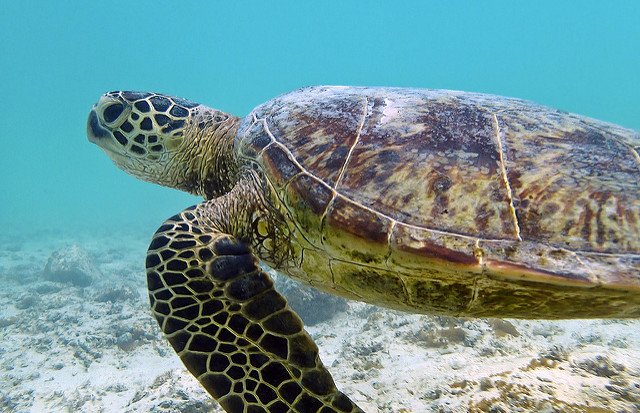It’s World Sea Turtle Day! Not to be confused with World Turtle Day on May 23, World Sea Turtle Day highlights the importance of and celebrates sea turtles swimming around the world.
Sea turtles live in oceans around the world, and some live to be 80-100 years old. There are seven types of sea turtles — green, loggerhead, Kemp’s ridley, olive ridley, hawksbill, flatback and leatherback — and all of them are endangered.
Here are some more facts you might not know about sea turtles.
1. They have been around for more than 100 million years.

Scientists estimate that sea turtles have been swimming around for 110 million years, which makes them as old as dinosaurs.
2. Sea turtles maintain the jellyfish population.

Leatherback and hawksbill turtles feed on jellyfish. Unfortunately, plastic resembles jellyfish floating in the water, so many sea turtles die from ingesting plastic.
3. They double as the ocean’s lawnmowers.

Green sea turtles eat seagrass. Similar to regular grass, seagrass needs to be kept short to ensure it stays healthy and that it continues to grow in the ocean. If it gets too long it can grow into blades, becoming harmful to other marine life.
4. The can hold their breath for up to five hours.

Sea turtles are reptiles, so they need oxygen to survive. However, they are the winner when it comes to holding their breath the longest. Sea turtles are able to slow their heart rate to up to nine minutes between each beat in order to conserve oxygen.
5. They cannot retract their head and legs into their shell.

Unlike land turtles, sea turtles don’t have much to protect themselves from once they mature, so they can’t retract their head and flippers. This does, however, make them more vulnerable when nesting and hatching.
6. The sex of baby sea turtles depends on the nest temperature.

Warmer nests can lead to more female babies, while cooler nests lead to more males. This is becoming a problem, though. Climate change can drastically alter the population of turtles, creating too many females and not enough males for reproduction.
7. They have a great sense of direction.

Sea turtles are able to sense the Earth’s magnetic field and use it as a compass. This is especially helpful during migrations.
8. They lay eggs in the same place every year.

Sea turtles return to the same beach every year to lay eggs, often within 100 yards of where the previous nest was located.
9. All seven species are on the endangered list.

Sea turtles face daily threats, such as becoming bycatch in commercial fishing, illegal trade and consumption, habitat loss and climate change. All of which are decreasing the population of sea turtles by tens of thousands.
10. You can help save sea turtles.
The World Wildlife Fund encourages everyone to take a pledge to buy certified sustainable seafood, shop consciously while traveling and support sea turtle ecotourism.